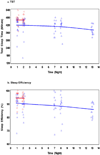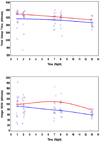Polysomnogram changes in marijuana users who report sleep disturbances during prior abstinence
- PMID: 20685163
- PMCID: PMC2938870
- DOI: 10.1016/j.sleep.2010.02.013
Polysomnogram changes in marijuana users who report sleep disturbances during prior abstinence
Abstract
Background: Abrupt discontinuation of heavy marijuana (MJ) use is associated with self-reports of sleep difficulty. Disturbed sleep is clinically important because MJ users experiencing sleep problems may relapse to MJ use to improve their sleep quality. Few studies have used polysomnography (PSG) to characterize changes in sleep architecture during abrupt abstinence from heavy MJ use.
Methods: We recorded PSG measures on nights 1, 2, 7, 8, and 13 after abrupt MJ discontinuation in 18 heavy MJ users residing in an inpatient unit.
Results: Across abstinence, Total Sleep Time (TST), Sleep Efficiency (SEff), and amount of REM sleep declined, while Wake after Sleep Onset (WASO) and Periodic Limb Movements (PLM) increased. Furthermore, quantity (joints/week) and duration (years) of MJ use were positively associated with more PLMs.
Conclusion: The treatment of sleep disturbance is a potential target for the management of cannabis use disorders since poor sleep could contribute to treatment failure in heavy MJ users.
Conflict of interest statement
Figures




Similar articles
-
Sleep disturbance in heavy marijuana users.Sleep. 2008 Jun;31(6):901-8. doi: 10.1093/sleep/31.6.901. Sleep. 2008. PMID: 18548836 Free PMC article.
-
Sleep architecture in adolescent marijuana and alcohol users during acute and extended abstinence.Addict Behav. 2009 Nov;34(11):976-9. doi: 10.1016/j.addbeh.2009.05.011. Epub 2009 May 23. Addict Behav. 2009. PMID: 19505769 Free PMC article.
-
The effects of oral nicotine administration and abstinence on sleep in male C57BL/6J mice.Psychopharmacology (Berl). 2019 Apr;236(4):1335-1347. doi: 10.1007/s00213-018-5139-6. Epub 2018 Dec 18. Psychopharmacology (Berl). 2019. PMID: 30564868 Free PMC article.
-
Effect of illicit recreational drugs upon sleep: cocaine, ecstasy and marijuana.Sleep Med Rev. 2008 Oct;12(5):381-9. doi: 10.1016/j.smrv.2007.12.004. Epub 2008 Mar 3. Sleep Med Rev. 2008. PMID: 18313952 Review.
-
Sleep in psychiatric disorders: where are we now?Can J Psychiatry. 2010 Jul;55(7):403-12. doi: 10.1177/070674371005500703. Can J Psychiatry. 2010. PMID: 20704767 Review.
Cited by
-
ATS Core Curriculum 2020. Adult Sleep Medicine.ATS Sch. 2020 Dec 30;1(4):476-494. doi: 10.34197/ats-scholar.2020-0017RE. ATS Sch. 2020. PMID: 33870314 Free PMC article.
-
The impact of cannabis use proximal to sleep and cannabinoid metabolites on sleep architecture.J Clin Sleep Med. 2024 Oct 1;20(10):1615-1625. doi: 10.5664/jcsm.11212. J Clin Sleep Med. 2024. PMID: 38804689
-
"Weeding out" violence? Translational perspectives on the neuropsychobiological links between cannabis and aggression.Aggress Violent Behav. 2024 Sep-Oct;78:101948. doi: 10.1016/j.avb.2024.101948. Epub 2024 Apr 19. Aggress Violent Behav. 2024. PMID: 38828012 Free PMC article.
-
Assessment of Withdrawal, Mood, and Sleep Inventories After Monitored 3-Week Abstinence in Cannabis-Using Adolescents and Young Adults.Cannabis Cannabinoid Res. 2022 Oct;7(5):690-699. doi: 10.1089/can.2021.0074. Epub 2021 Oct 22. Cannabis Cannabinoid Res. 2022. PMID: 34678051 Free PMC article.
-
The Effects of Lithium Carbonate Supplemented with Nitrazepam on Sleep Disturbance during Cannabis Abstinence.J Clin Sleep Med. 2015 Oct 15;11(10):1153-62. doi: 10.5664/jcsm.5090. J Clin Sleep Med. 2015. PMID: 26285109 Free PMC article. Clinical Trial.
References
-
- Substance Abuse and Mental Health Services Administration. Results from the 2006 National Survey on Drug Use and Health: National Findings (Office of Applied Studies) Rockville, MD: NSDUH Series H-32 ed.; 2007.
-
- Compton WM, Pringle B. Services research on adolescent drug treatment. Commentary on "The Cannabis Youth Treatment (CYT) Study: main findings from two randomized trials". J Subst Abuse Treat. 2004 Oct;27(3):195–196. - PubMed
-
- Moore BA, Budney AJ. Relapse in outpatient treatment for marijuana dependence. Journal of Substance Abuse Treatment. 2003 Sep;25(2):85–89. - PubMed
-
- Budney AJ, Hughes JR, Moore BA, Vandrey R. Review of the validity and significance of cannabis withdrawal syndrome. American Journal of Psychiatry. 2004 Nov;161(11):1967–1977. - PubMed
Publication types
MeSH terms
Grants and funding
LinkOut - more resources
Full Text Sources
Medical

